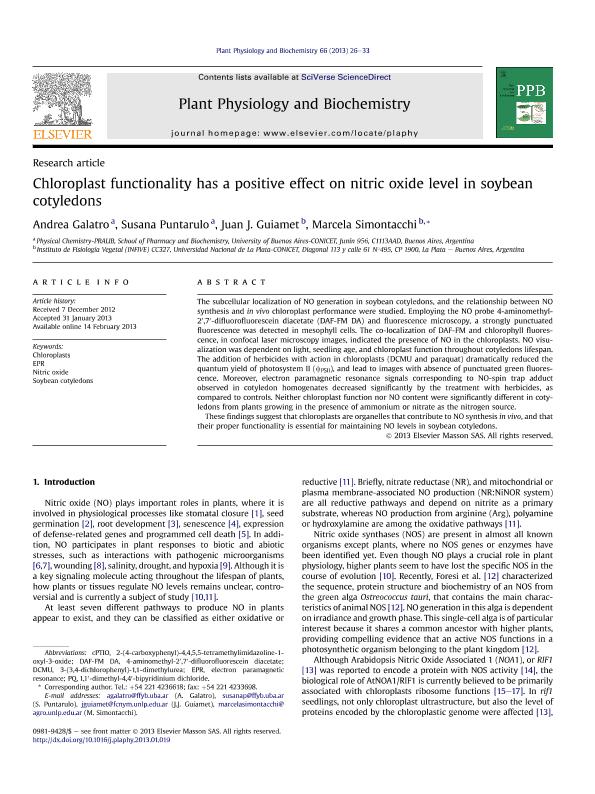Artículo
Chloroplast functionality has a positive effect on nitric oxide level in soybean cotyledons
Galatro, Andrea Verónica ; Puntarulo, Susana Ángela
; Puntarulo, Susana Ángela ; Guiamet, Juan José
; Guiamet, Juan José ; Simontacchi, Marcela Silvia
; Simontacchi, Marcela Silvia
 ; Puntarulo, Susana Ángela
; Puntarulo, Susana Ángela ; Guiamet, Juan José
; Guiamet, Juan José ; Simontacchi, Marcela Silvia
; Simontacchi, Marcela Silvia
Fecha de publicación:
05/2013
Editorial:
Elsevier Masson
Revista:
Plant Physiology and Biochemistry
ISSN:
0981-9428
Idioma:
Inglés
Tipo de recurso:
Artículo publicado
Clasificación temática:
Resumen
The subcellular localization of NO generation in soybean cotyledons, and the relationship between NO synthesis and in vivo chloroplast performance were studied. Employing the NO probe 4-aminomethyl-2′,7′-difluorofluorescein diacetate (DAF-FM DA) and fluorescence microscopy, a strongly punctuated fluorescence was detected in mesophyll cells. The co-localization of DAF-FM and chlorophyll fluorescence, in confocal laser microscopy images, indicated the presence of NO in the chloroplasts. NO visualization was dependent on light, seedling age, and chloroplast function throughout cotyledons lifespan. The addition of herbicides with action in chloroplasts (DCMU and paraquat) dramatically reduced the quantum yield of photosystem II (ϕPSII), and lead to images with absence of punctuated green fluorescence. Moreover, electron paramagnetic resonance signals corresponding to NO-spin trap adduct observed in cotyledon homogenates decreased significantly by the treatment with herbicides, as compared to controls. Neither chloroplast function nor NO content were significantly different in cotyledons from plants growing in the presence of ammonium or nitrate as the nitrogen source. These findings suggest that chloroplasts are organelles that contribute to NO synthesis in vivo, and that their proper functionality is essential for maintaining NO levels in soybean cotyledons.
Palabras clave:
Nitric Oxide
,
Soybean Cotyledons
,
Chloroplasts
,
Epr
Archivos asociados
Licencia
Identificadores
Colecciones
Articulos(IBIMOL)
Articulos de INSTITUTO DE BIOQUIMICA Y MEDICINA MOLECULAR
Articulos de INSTITUTO DE BIOQUIMICA Y MEDICINA MOLECULAR
Citación
Galatro, Andrea Verónica; Puntarulo, Susana Ángela; Guiamet, Juan José; Simontacchi, Marcela Silvia; Chloroplast functionality has a positive effect on nitric oxide level in soybean cotyledons; Elsevier Masson; Plant Physiology and Biochemistry; 66; 5-2013; 26-33
Compartir
Altmétricas



